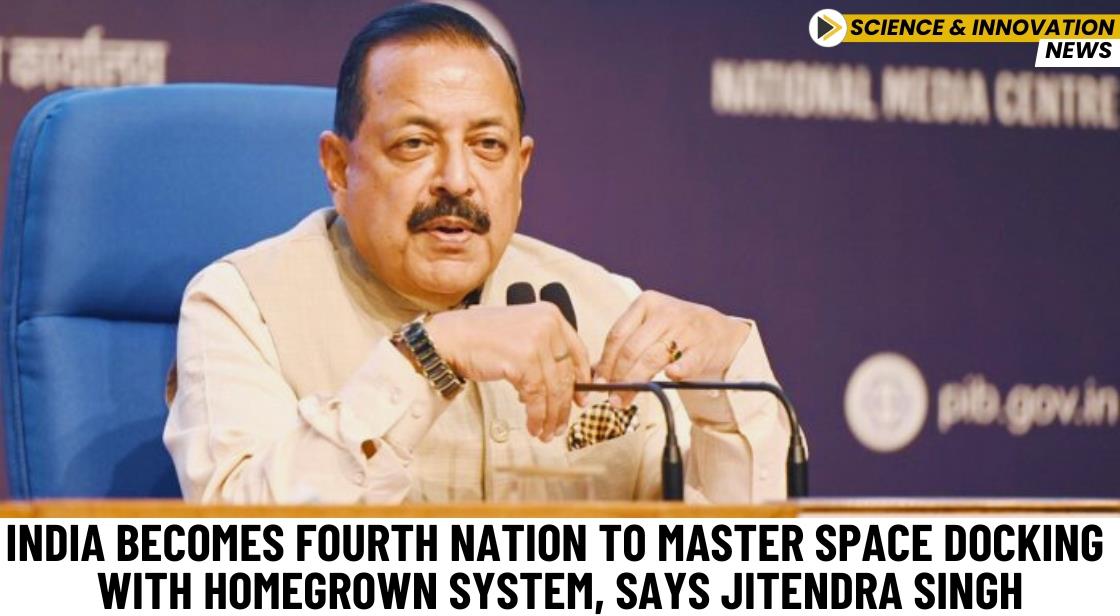India Becomes Fourth Nation to Master Space Docking with Homegrown System, Says Jitendra Singh

News Synopsis
India has achieved a significant milestone in its space exploration journey by becoming the fourth nation in the world to successfully perform space docking using its own indigenously developed "Bharatiya Docking System." The successful demonstration of this technology took place during ISRO's SpaDeX mission on Monday, marking a monumental achievement for India's space program.
Praise for Prime Minister Narendra Modi’s Vision
Union Minister Jitendra Singh expressed his appreciation for Prime Minister Narendra Modi's visionary leadership, acknowledging his contributions to making this milestone possible. In a post on X, Singh credited Modi’s vision for an “Atmanirbhar Bharat” (Self-Reliant India) and his commitment to space exploration. The minister hailed Modi’s mantra, which has paved the way for India's advancements in space technologies, including the ambitious "Gaganyaan" mission and plans for the indigenous "Bharatiya Antriksha Station."
Congratulatory Messages from Union Home Minister Amit Shah
Union Home Minister Amit Shah also congratulated ISRO on its remarkable achievement. Shah referred to the successful launch of the SpaDeX mission as a groundbreaking step, emphasizing that it brings India closer to joining an elite group of nations that have mastered space docking technology. In a post on X, Shah praised ISRO's efforts, stating that the mission represents a significant leap forward in space technology and strengthens India's role as a global leader in space exploration.
SpaDeX Mission: A Key Step Toward India’s Space Ambitions
The SpaDeX mission, which was launched as part of ISRO's year-end project, aimed to demonstrate India’s ability to dock two satellites in space. This cost-effective technology demonstration uses two small spacecraft, SDX01 and SDX02, to validate and test in-space docking capabilities. The technology demonstrated during this mission is vital for ISRO's future space missions, including Chandrayaan-4, the Indian Space Station, and the much-awaited Gaganyaan manned space mission.
Space Docking Critical for Chandrayaan-4 Mission
The success of the SpaDeX mission has significant implications for ISRO’s upcoming projects, particularly the Chandrayaan-4 mission. ISRO Chairman S. Somanath highlighted the importance of space docking for the Chandrayaan-4 mission, which is expected to launch in 2025. The Chandrayaan-4 mission will consist of five modules, each launched separately and later integrated into two separate modules that need to dock in both Earth and Moon orbit. Docking is considered crucial for the mission’s success, as it involves landing on the Moon and returning to Earth.
ISRO's 99th Launch and Preparation for 100th Launch
Somanath also celebrated ISRO’s 99th launch milestone, which was achieved with the successful launch of PSLV-C60. The mission placed two SpaDeX satellites into a 475-kilometer circular orbit, further proving the effectiveness of the space docking system. Somanath emphasized that ISRO is preparing for its 100th launch, which is scheduled for early next year, further solidifying the organization's track record of successful space missions.
Upcoming Mission: Launch of NVS-02 Satellite
Looking ahead, ISRO is gearing up for the launch of the NVS-02 satellite aboard the Geosynchronous Satellite Launch Vehicle (GSLV) in January 2025. The NVS-02 mission is designed to enhance the Indian Navigation with Indian Constellation (NavIC) system by advancing capabilities introduced by the NVS-01 satellite launched in 2023. The NVS-01 satellite featured an indigenous atomic clock and improved service coverage with L1 band signals, making it a key asset for India’s satellite navigation system.
A Busy Year Ahead for ISRO in 2025
Somanath confirmed that 2025 will be a busy year for ISRO, with multiple missions lined up, starting with the NVS-02 satellite launch in January. The year will also see the continuation of ISRO's efforts to develop space docking technology, with further missions planned for the Indian Space Station and Gaganyaan. The achievements thus far have positioned India as a key player in space exploration, setting the stage for even greater accomplishments in the coming years.
You May Like









